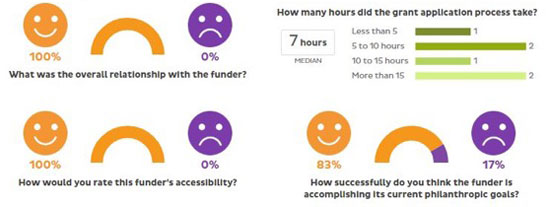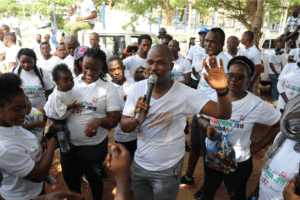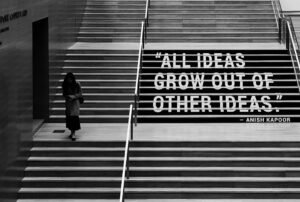
For more than a decade, the Center for Effective Philanthropy (CEP) has pioneered evaluating philanthropy through initiatives and customer feedback products including Grantee and Applicant Perception Reports, research, publications, and convenings.
This week, nearly 500 people nationwide will gather on May 7–9, 2019 for CEP’s biennial conference hosted in Minneapolis, MN to address pressing issues facing the field, such as how to best evaluate social impact, what true capacity-building looks like in nonprofits, and how to incorporate feedback to improve the work of the conference’s singular intended audience: staff and board members of foundations.
Nonprofit organizations aren’t invited to attend the conference this week (though a handful are presenting at various breakout sessions). Like any industry-specific conference, it’s common for members of a field to get together only with themselves to discuss topics of mutual concern (sometimes promoted as “safe spaces”). The thin representation of nonprofit organizations at CEP isn’t necessarily a problem in and of itself, but becomes one when it symbolizes a larger dynamic that deserves attention.
That dynamic is exclusion and elite agenda-setting, offering limited opportunities for the full community that is impacted by philanthropy to participate in key conversations where priorities get set, decisions get made, and ideas get funded.
This dynamic is mirrored in CEP’s Grantee and Applicant Perception Reports.
How Grantee Perception Reports work
To be able to report on the relationship a foundation has with its community, foundations commission CEP to actively solicit opinions from organizations receiving grant funds from the foundation. Results are shared with the foundation, and the foundation chooses what portion of the findings will be made public, if anything. To date over 320 foundations have commissioned a Grantee Perception Report.
CEP deserves credit for creating an opportunity for nonprofit organizations to give feedback to foundations and potentially inform their planning, practices, processes, and priorities.
Measuring “grantee perceptions” as CEP does is an important first step to hearing the customer voice, but there are some crucial limitations with this approach for those seeking to fully understand impact and strive for effective philanthropy:
- The vast majority of CEP surveys are limited to successful applicants. (CEP does give foundations the option to also survey declined applicants through Applicant Perception Reports, but this is not commonly used—67 out of 320 foundations have opted to do so.) Other key perspectives (such as unsuccessful grant applicants, people impacted by the funded work, etc.) are generally left out so those reports’ findings are likely skewed.
- The current survey requires a noteworthy investment from nonprofits. My peers and I have found that with more than 50 questions, the survey can take more than an hour to complete.
- Though the reports offer analysis that is benchmarked against an aggregate of peers, it appears from CEP’s website that only one in five foundations have some aspect of their Grantee Perception Report currently made public, which limits trans-field learning.
In CEP’s approach through the Grantee Perception Reports, “effective philanthropy” is defined by current grantees’ perceptions of a foundation. It is hard to imagine serious market research primarily limited to current customers. Or, as one large foundation leader observed:
Sign up for our free newsletters
Subscribe to NPQ's newsletters to have our top stories delivered directly to your inbox.
By signing up, you agree to our privacy policy and terms of use, and to receive messages from NPQ and our partners.
“We are completely transparent about all the positive feedback we receive.”
What’s at stake when “effective philanthropy” is defined from the top
Without incorporating all of the voices of those impacted by the work, there’s a risk of unintentionally perpetuating trends and practices that are unquestioned, not inclusive, inefficient, and even harmful. One of the most poignant critiques by CEP conference keynote speaker Anand Giridharadas in his timely exposé Winners Take All is the threat to democracy posed by “market world’s” ruling hyper-wealthy elite who determine what initiatives, speakers, and topics warrant special attention (and what ideas get put into practice through funding). Attention and money can function like oxygen in a room—there’s a finite amount, and it’s suffocating when a small group sucks up most of it.
Philanthropy has a great deal of influence and can be one of the most powerful perpetuators of this phenomenon, especially when the attention is accompanied by resources with conditions. Foundation leaders attending conferences, affinity groups, meetings, and seminars with one another risk hearing only from a chosen few, then generate big ideas and return to their communities with strategies that are free from constituent vetting or nonprofit input.
Foundation-funded initiatives can be powerful drivers of special attention. Social impact bonds, impact investing, collective impact, resiliency, grants management software, and complex impact evaluation are trends that have captivated the attention of the broader funding and consultant community in recent years but have been insufficiently vetted.
While each new thing might be considered a helpful resource, framework, or tool for nonprofit organizations, they are not a universal fit. Without input from or dynamic conversation with the full community impacted by the work, the risks are:
- immense resources get expended implementing early versions of ideas;
- foundations lose perspective on how their funding is a crucial driver that contributes to a broader revenue map of nonprofit organizations, making significant changes in the processes and direction of their funding; and
- nonprofit organizations are left with the consequences: significant time wasted in inefficient processes (such as poorly designed online grants management systems), under-funded core operations, and/or are forced to expand services or mission to accommodate the newfound interests of funders.
An opportunity and invitation for Foundations
If you are attending the conference or are one of the 320 foundations who have asked your grantees to complete a Grantee Perception Report (GPR) by the Center for Effective Philanthropy (CEP), nonprofits and GrantAdvisor commend you.
GrantAdvisor shares the goal of open communication between grantmakers and grantseekers, which has the potential to transform organizations and communities. People impacted by philanthropy have a proven interest in providing honest, complete feedback, reviewing over 600 foundations in 47 states during GrantAdvisor’s startup phase. Those voices must be included and considered in collective efforts to identify the places and processes by which power and resources get invested.
CEP has blazed a trail of evaluating philanthropy but provides an incomplete report. Beyond audience-limited conversations at a conference or an atomizing review of an individual organization’s perceptions of their interactions with a singular foundation, a crucial part of the dialogue must also include the full community and be publicly accessible. The full measure of “effective philanthropy” is the foundation’s impact on communities, and that impact is best captured when voices of all affected by the philanthropy are heard.
Further Thoughts for Foundations
GrantAdvisor reviewers clearly want philanthropy to succeed, and there are some great resources out there that help meaningfully incorporate feedback from the broader community into decision-making and process design. Here are some of the best we have seen:
- Deepen knowledge of different models for participatory grantmaking and trust-based philanthropy. The Ford Foundation and Foundation Center have commissioned some amazing pieces on participatory grantmaking (here and here) and a handful of cutting-edge funders are pioneering new practices that deeply engage the feedback and lived experiences of grantees through trust-based philanthropy.
- Check out what the Fund for Shared Insight is leading with their Listen4Good initiative and consider how this initiative can be applied to grantmaking. Listen4Good helps nonprofit organizations build high-quality and client-focused feedback loops out of a belief that meaningful change comes by systematically listening and responding to the people they seek to help.
- Deepen knowledge and appreciation of the varying business models of nonprofit operations and how philanthropy fits into the broader revenue stream. Keep this in mind when hot, new funding trends in philanthropy emerge and understand the impact of your funding priorities and processes on nonprofits. The Nonprofit Quarterly has featured some amazing articles and webinars on nonprofit business models and funding streams over the years.
To read the remainder, readers can go to blog.GrantAdvisor.org.











